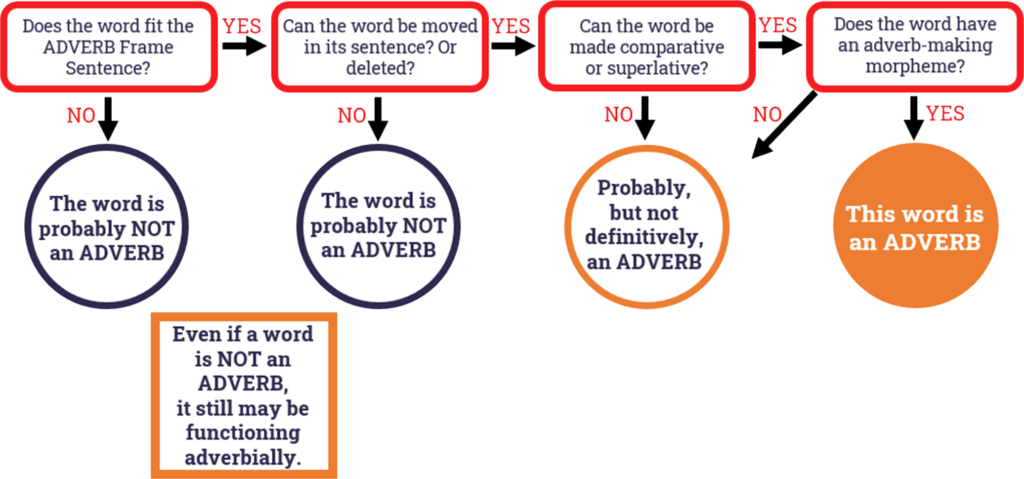chapter 1: adverbs
An ADVERB is a form-class word that usually modifies verbs, adjectives, adverbs, phrases, clauses, or a whole sentence. A primary test for adverbs/adverbials is that it frequently can be moved around in its sentence, or deleted, and the sentence will still make sense.
A prototypical adverb will have five characteristics:
- Adverb-making morpheme
- Comparative or Superlative (using an inflectional morpheme) [-er] or [-est]
- Comparative or Superlative (using MORE or MOST)
- Move in its sentence (or deleted)
- Can fit the adverb frame sentence: The man told his story <BLANK>.
These five characteristics serve as the primary tests for identifying adverbs.
In general, a prototypical adverb will have 4-5 of these characteristics. The more adverb characteristics a word has, the more prototypical it is. The fewer adverb characteristics a word has, the more it becomes a peripheral case. They share many inflectional and derivational morphemes with adjectives. No single formal or functional characteristic can identify every adverb.
You can only be sure a word is an adverb if it fits the frame sentence. The frame sentence can be any complete sentence with a final slot available for an optional adverb. For example, the frame sentence could be:
- The woman walked her dog _____.
- The man told his story _____.
- The child cried _____.
- The dog ate his bone _____.
Prototypical adverbs like slow, slowly, fast, gladly, mechanically, and basically fit these sentences and have other characteristics of prototypical adverbs:
Has an adverb-making morpheme:
- slowlygladlymechanically
- basically
Takes a comparative or superlative morpheme:
- faster, fastest
- slower, slowest
Can be made comparative or superlative by using more or most:
- more gladly, more mechanically
- most gladly, most mechanically
Can be qualified:
- rather slowlyvery fastquite gladly
- most basically
Can be moved within a sentence:
- He ate gladly.He gladly ate.
- Gladly he ate.
Members of all four form classes can be divided into further subclasses based on certain semantic features. These features often have grammatical consequences. Adverb subclasses include adverbs that describe the following categories:
- Manner
- Time
- Place
- Degree
- Frequency and Number
- Duration
When analyzing for adverbs, we classify the FORM of the analyzed word as adverb. You can use the following flowchart as a guide for your analysis:


